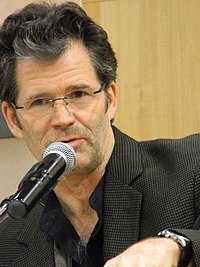Erik Larson, The Devil in the White City
 |
| Andre Dubus III |
If the introductions of speakers, and sometimes the introductory comments made by the speakers themselves, can often be tedious, introductory passages in books can be equally so. Erik Larson's book itself has a prologue. Looking over some of the other books on my shelves, I found one with both a foreword and a prologue, another with a preface and an introduction, yet another with a foreword and a preface, and another with an introduction and two prefaces, one by the author and another by the editor.
It gets confusing, even for writers and editors, to understand what all these terms mean, but technically a preface is not the same thing as a prologue, which is different from both a foreword and an introduction. (We won't even get into afterword and epilogue.) A foreword, for example, is usually written by someone other than the author. The introduction "usually forms a part of the text (and the text numbering system)," according a source I found with a Google search. Of course, there are exceptions. My Bookstore, a book of essays by writers about favorite bookstores, includes an introduction by Richard Russo with Roman numerals.
I try to read introductions, prefaces and all the rest, and sometimes they can be helpful. Prologues especially tend to be vital to the book, although I often wonder why a prologue can't just be called Chapter One. Yet they can all be annoying at times, especially when they are numbered with Roman numerals, making it seem like you have to read page after page before you can actually start the book, and especially in fiction. "Get down to the story!" we want to shout. "Get down to the facts!"
No comments:
Post a Comment